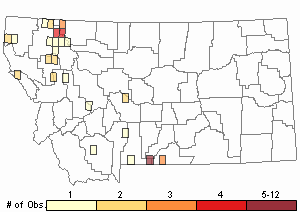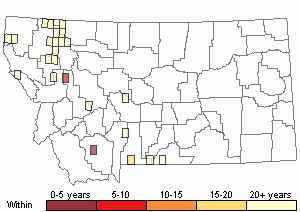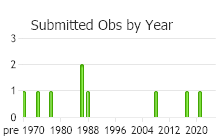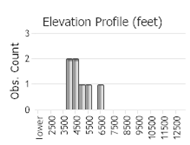View in other NatureServe Network Field Guides
NatureServe
Montana
Utah
Wyoming
Idaho
Wisconsin
British Columbia
South Carolina
Yukon
California
New York
Lurid Boat Moss - Hygrohypnum luridum
General Description
Plants: Pleurocarpous (Vitt 1988), growing in mats or clumps (Lawton 1971), soft, green with yellow tones and sometimes dappled with russet, less often ochre or vivid- to deep-green, commonly one plant exhibiting more than one color and intergradations (FNA 2014), a bit glossy (Crum and Anderson et al. 1981). Stems sometimes reaching 6 cm, typically with leaves all over (rather than leaves stripped or only leaf base fragments remaining along the stem base), freely branching (FNA 2014), the branches sometimes curved at the tips (Lawton 1971), lacking a hyalodermis, possessing a central strand; paraphyllia lacking (FNA 2014).
Leaves: Usually overlapping and catkin-like, straight or curved in sickle-like fashion, seldom with the ends coiled into a circle, similar wet or dry, 0.5-2.5 mm in length, 0.3-1.1 mm in width, moderately cupped, not pleated, lance-shaped, sometimes with oblong tendencies, egg-shaped, or sometimes widely so, tapering to an acute leaf tip, seldom to a short apiculus; leaf edges smooth, usually rolled inward; costa variable within a plant, being paired and short, single and short to long, sometimes reaching the apex, or lacking (FNA 2014), yellowish (Crum and Anderson et al. 1981).
Leaf Cells: Cell walls nonporose (Lawton 1971); medial cells short and somewhat diamond-shaped to very slender and a little bent, longer and narrower than the basal laminal cells; apical cells shorter than medial cells; margins unbordered; alar cells short and oblong to square or oddly-shaped, numerous, the walls fine and transparent or thick and pigmented, the alar area generally distinct from adjacent regions (FNA 2014).
Range Comments
North American Range
Canada: YT to NU, BC to NB and NL; USA: AK, WA, CA, ID and WY s to AZ and NM, also MN, MI se to WV, NY, NJ, NH and VT (FNA 2014). Known in Montana from Carbon, Cascade, Flathead, Gallatin, Glacier, Lake, Lincoln, Lewis and Clark, Meagher, Mineral, Park, and Sanders Counties (Elliott and Pipp 2016).
Observations in Montana Natural Heritage Program Database
Number of Observations: 52
(Click on the following maps and charts to see full sized version)
Map Help and Descriptions
Relative Density

Recency



 (Observations spanning multiple months or years are excluded from time charts)
(Observations spanning multiple months or years are excluded from time charts)
Habitat
On wet stones and wood in and along watercourses (FNA 2014), especially around tumbling water, including waterfalls; calciphilic (Crum and Anderson et al. 1981). Ranging in elevation from lowlands to 10,500 feet (FNA 2014).
Reproductive Characteristics
Autoicous (FNA 2014). Exterior perichaetial leaves spreading to 90 degrees; interior perichaetial leaves pleated, sometimes reaching 3.5 mm in length, the margins smooth, the costa long and solitary (Lawton 1971). Seta 8-24 mm tall, ochre (FNA 2014). Capsule somewhat bowed, the theca sometimes reaching 2.5 mm in length, contracted below the opening when dry (Lawton 1971); exostome teeth somewhat ochre or brownish (Crum and Anderson et al. 1981); endostome cilia similar in length to the processes but delicate and frequently not intact (Lawton 1971).
Stewardship Responsibility
References
- Literature Cited AboveLegend:
 View Online Publication
View Online Publication Crum, H.A. and L.E. Anderson. 1981. Mosses of Eastern North America. 2 volumes. Columbia University Press, New York. 1328 pp.
Crum, H.A. and L.E. Anderson. 1981. Mosses of Eastern North America. 2 volumes. Columbia University Press, New York. 1328 pp. Elliott, J.C. and A.K. Pipp. 2018. A Checklist of Montana Mosses (1880-2018). Updated 3 January, 2020. Montana Natural Heritage Program, Helena, Montana. 73 pp.
Elliott, J.C. and A.K. Pipp. 2018. A Checklist of Montana Mosses (1880-2018). Updated 3 January, 2020. Montana Natural Heritage Program, Helena, Montana. 73 pp. Flora of North America Editorial Committee, eds. 2014. Flora of North America North of Mexico. Volume 28. Bryophytes: Mosses, Part 2. Oxford University Press, Inc., NY. xxi + 702 pp.
Flora of North America Editorial Committee, eds. 2014. Flora of North America North of Mexico. Volume 28. Bryophytes: Mosses, Part 2. Oxford University Press, Inc., NY. xxi + 702 pp. Lawton, E. 1971. Moss Flora of the Pacific Northwest. Hattori Botanical Laboratory. Japan: Yamabuki-cho, Shinjuku-ku, Tokyo. 362 pages plus appendices.
Lawton, E. 1971. Moss Flora of the Pacific Northwest. Hattori Botanical Laboratory. Japan: Yamabuki-cho, Shinjuku-ku, Tokyo. 362 pages plus appendices. Vitt, D. J. Marsh, and R. Bovey. 1988. Mosses, Lichens & Ferns of Northwest North America. Seattle, WA: University of Washington Press. 296 p.
Vitt, D. J. Marsh, and R. Bovey. 1988. Mosses, Lichens & Ferns of Northwest North America. Seattle, WA: University of Washington Press. 296 p.
- Additional ReferencesLegend:
 View Online Publication
View Online Publication
Do you know of a citation we're missing? Elliot, J. C. 1993. Second checklist of Montana mosses. Unpublished report. U.S. Forest Service, Region 1. Missoula, MT. 45 pp.
Elliot, J. C. 1993. Second checklist of Montana mosses. Unpublished report. U.S. Forest Service, Region 1. Missoula, MT. 45 pp. Flowers, S. 1973. Mosses: Utah and the West. Brigham Young University, Provo, Utah. 567 p.
Flowers, S. 1973. Mosses: Utah and the West. Brigham Young University, Provo, Utah. 567 p. Lawton, E. 1971. Keys for the Identification of the Mosses on the Pacific Northwest. Reprinted from 'Moss Flora of the Pacific Northwest'. Published as Supplement No. 2 of the Journal of the Hattori Botanical Laboratory. Nichinan, Miyazaki, Japan. 66 pp.
Lawton, E. 1971. Keys for the Identification of the Mosses on the Pacific Northwest. Reprinted from 'Moss Flora of the Pacific Northwest'. Published as Supplement No. 2 of the Journal of the Hattori Botanical Laboratory. Nichinan, Miyazaki, Japan. 66 pp. Malcolm, B., N. Malcolm, J. Shevock, and D. Norris. 2009. California Mosses. Nelson, New Zealand: Micro-Optics Press. 430 pp.
Malcolm, B., N. Malcolm, J. Shevock, and D. Norris. 2009. California Mosses. Nelson, New Zealand: Micro-Optics Press. 430 pp. Rasmussen, S.M. 1968. Composition and structure of macrophyte vegetation of the Firehole River, Yellowstone National Park as related to physical and chemical factors. M.Sc. Thesis. Bozeman, MT: Montana State University. 44 p.
Rasmussen, S.M. 1968. Composition and structure of macrophyte vegetation of the Firehole River, Yellowstone National Park as related to physical and chemical factors. M.Sc. Thesis. Bozeman, MT: Montana State University. 44 p. Smith, A.J.E. 1980. The Moss Flora of Britain and Ireland. Cambridge University Press, Cambridge. 705 pp.
Smith, A.J.E. 1980. The Moss Flora of Britain and Ireland. Cambridge University Press, Cambridge. 705 pp.
- Web Search Engines for Articles on "Lurid Boat Moss"





